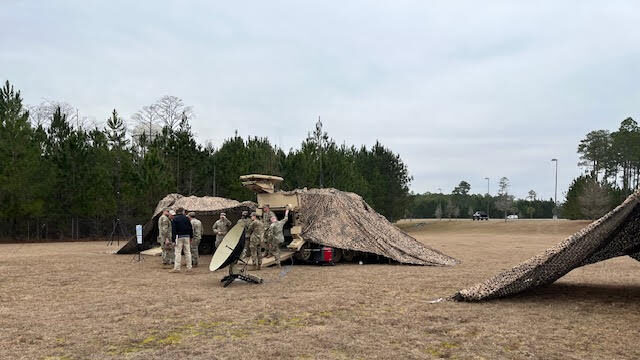
Army armored formation network pilot PEO C3T at Ft. Stewart. (Andrew Eversden/Breaking Defense)
SATELLITE 2022: The Army will hold an industry day April 20 for it’s long-awaited pilot program to explore buying satellite communication services in the same way that civilians subscribe to a mobile phone plan, with an eye on making awards in fiscal 2023, service officials told Breaking Defense today.
Over the past year, the Army held a series of demonstrations involving some 20 companies to prove that commercial providers could meet the service’s needs. Now the service is keen to gather specific industry ideas for how it might pay for access to bandwidth under the effort, called “SATCOM as a Managed Service (SaaMS),” said Brig. Gen. Rob Collins, who heads the Program Executive Office (PEO) Command, Control, & Communications – Tactical (C3-T).
“We’re looking for everything from: how do we do the bandwidth utilization, what are some of the pricing models, how do we train this, how do we secure this even down to the supply chain,” he said.
One key question, he explained, revolves around how terminals can be accessed under any service agreement — a big deal for the Army, which has to ensure the connectivity of thousands of individual soldiers. Those thousands have widely diverse communications needs, but at the same time want equipment — from handheld radios to truck mounted antennas — that is simple to use and/or set up in the field.
“Can we engage in some type of a proposition where, without buying new terminals, we can get some type of a modernization?” he said.
Col. Shane Taylor, who heads up the pilot effort for the C3-T team, told Breaking Defense that the current plan is to pick “multiple vendors” to go forward with the pilot program, but that the service hasn’t yet figured out how many. This is because the Army wants to consider different use cases, with an eye towards comparing the costs and benefits of moving to a service model for each — with a key factor being how the new capabilities can be integrated into the existing Army C3 architecture.
“This is a fact finding [effort]. And so the more folks that we can get involved, the better. Obviously, resources dictate how many we can do, but for right now there’s not a set number. We’re truly going to be kind of driven by the use cases and we’re looking at a variety of the use cases,” he said. “So, what we’re going to do is, we’re going to be able to compare and contrast within each of those use cases, not really amongst each other, but how we do it today versus that use case.”
Commercial SATCOM providers have long urged DoD and the services to move from buying bandwidth in fits and starts to contracts that resemble a civilian’s average mobile phone or cable TV/Internet plan. Major SATCOM providers — such as Hughes (a subsidiary of SATCOM giant Echostar), Viasat, Intelsat, Inmarsat, SES and Eutelsat — argue that this would not only ease problems with service gaps that have long plagued troops in the field, but also be cheaper and allow speedier integration of new technology.
After the industry day the Army will go over the feedback, then issue a formal request for proposals in the third quarter of this year, Taylor said. Awards will be made in the second quarter of FY23, with the pilot program running for a few months afterwards.
Once the pilot is finished, the C3-T team will pour over the results and decide whether to move forward with a program of record, then set requirements and budget. All that will take some time, he explained, so the service is looking to FY24 as the earliest possible implementation of a formal program.






















